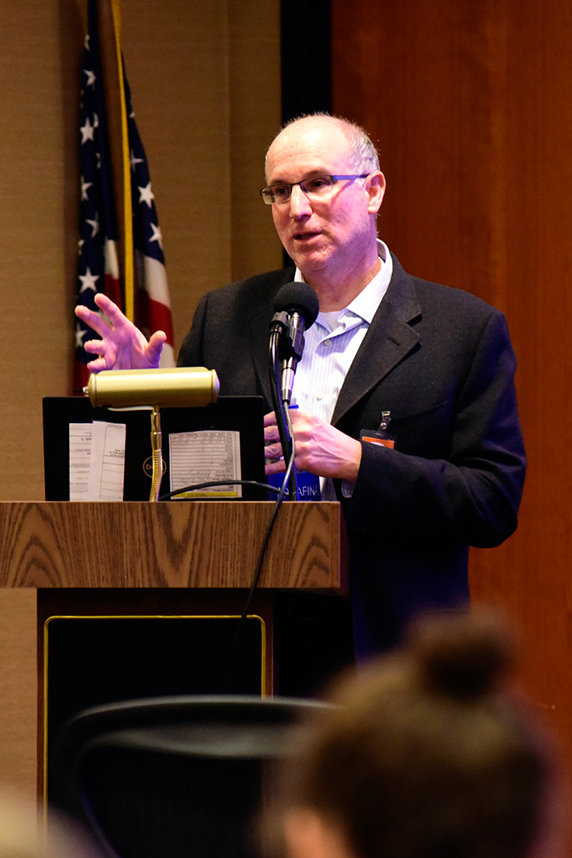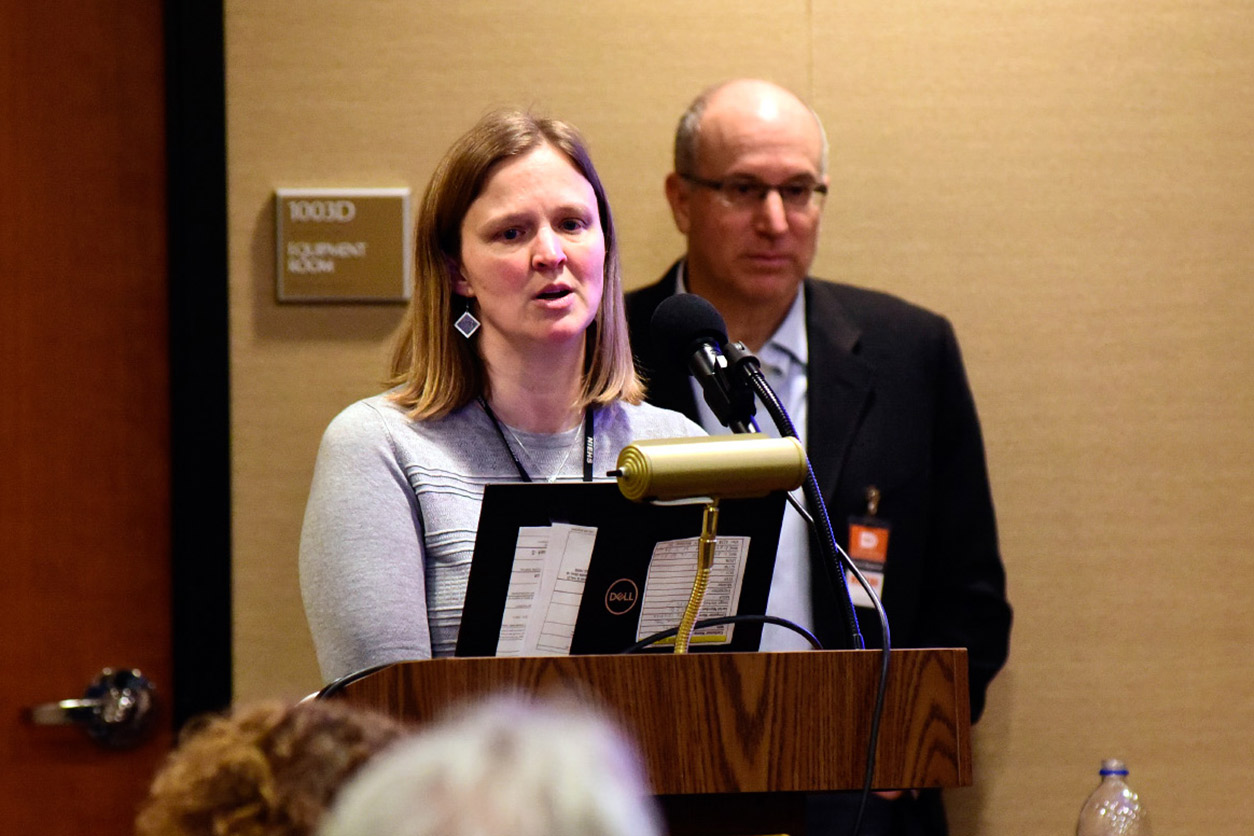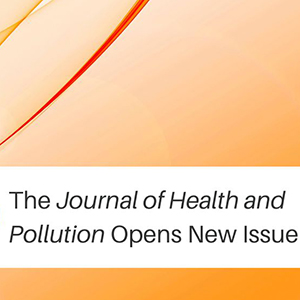 Hauser described data collection challenges in the EARTH study. (Photo courtesy of Steve McCaw)
Hauser described data collection challenges in the EARTH study. (Photo courtesy of Steve McCaw)Before a child is conceived, a man’s environment and his related lifestyle choices, such as the food he eats, may affect his fertility and the health of his child, according to Russ Hauser, M.D., Sc.D., from the Harvard T.H. Chan School of Public Health.
Hauser is the lead researcher of a unique study that collects detailed information from both parents before pregnancy is achieved. He said that research on health effects from exposures that occur before conception, especially those experienced by fathers, lags behind other topics in reproductive environmental health.
The NIEHS-funded Environment and Reproductive Health (EARTH) study examines how preconceptual exposures affect fertility, pregnancy outcomes, and the later health of children. Hauser discussed the importance of paternal exposures during a Feb. 26 Keystone Science Lecture.
Fertility center clients
EARTH study participants are drawn from women and men who seek fertility evaluation and treatment at the Massachusetts General Hospital Fertility Center.
“Dr. Hauser leads two cohort studies that explore the impact on fertility and reproduction from a variety of environmental exposures, including flame retardants, traffic, and pesticide residue intake from fruits and vegetables,” said Abee Boyles, Ph.D., a health scientist administrator at NIEHS who hosted the lecture. “He also mentors many scientists and chairs a large environmental health department.”
 Boyles introduced Hauser at NIEHS. (Photo courtesy of Steve McCaw)
Boyles introduced Hauser at NIEHS. (Photo courtesy of Steve McCaw)Exposures before conception
“Some environmental chemical exposures may disrupt fertility in men and women or affect pregnancy outcomes,” said Hauser. “The exposure may be at very low levels, but there is data from epidemiological and animal studies suggesting adverse effects.”
One of Hauser’s projects measured levels of two chemicals used in plastics — bisphenol A (BPA) and a phthalate known as DEPH — in the urine of mothers and fathers. Scientists compared the urinary levels with later data on preterm birth.
Unpublished results suggested that the risk of preterm birth is increased when mothers were exposed to either chemical or when fathers were exposed to the phthalate.
In another study, Hauser and colleagues examined urinary phthalate levels in mothers and fathers before conception and then behavior of their children at ages 2 to 9 years.
 Hauser’s studies build our understanding of how a father’s environmental exposures affect his fertility and the birth and health of his baby.
Hauser’s studies build our understanding of how a father’s environmental exposures affect his fertility and the birth and health of his baby.In mothers, phthalate exposure before conception was associated with increased hyperactivity and aggression behaviors in boys but not in girls. In fathers, phthalate exposure before conception was associated with increased anxiety, depression, and physical symptoms associated with those conditions. Scientists observed a decrease of these behaviors in girls.
Following the children
Hauser wanted to further research the effects on child health from exposures to parents — especially fathers — before they conceive. So in 2018, with Joseph Braun, Ph.D., from Brown University, he launched the Preconception Environmental Exposure and Childhood Health Effects (PEACE) study. Through this effort, scientists will gather health data about children born to couples who have participated in the EARTH study since 2005.
“While knowledge about health effects in children from parental environmental exposures is increasing, many questions related to certain aspects of children’s health are unanswered,” he explained.
Researchers will examine children’s intelligence quotients, behavior, executive function, body composition, and metabolic disease risk factors.
 Thad Schug, Ph.D., and others listened during to the discussion after Hauser’s talk. Schug oversees NIEHS research grants in reproductive health, endocrine system disruption, nanotechnology, and other areas. (Photo courtesy of Steve McCaw)
Thad Schug, Ph.D., and others listened during to the discussion after Hauser’s talk. Schug oversees NIEHS research grants in reproductive health, endocrine system disruption, nanotechnology, and other areas. (Photo courtesy of Steve McCaw)Sharing data and samples
EARTH study researchers have relied on scientists at other universities and organizations, such as the Centers for Disease Control and Prevention, to help them with measuring biological samples and other assistance. At the same time, other researchers are using data and samples from the EARTH study for their own projects.
“We’re very pleased to see the scientific coordination that occurs in the EARTH study,” said Boyles. “These efforts align with NIEHS’ goals for enhancing the environmental health sciences through promotion of collaborative science.”
Citation: Messerlian C, Bellinger D, Minguez-Alarcon L, Romano ME, Ford JB, Williams PL, Calafate AM, Hauser R, Braun JM. 2017. Paternal and maternal preconception urinary phthalate metabolite concentrations and child behavior. Env Res 158:720–728.
(Carol Kelly is a technical writer and editor in the NIEHS Office of Communications and Public Liaison.)









